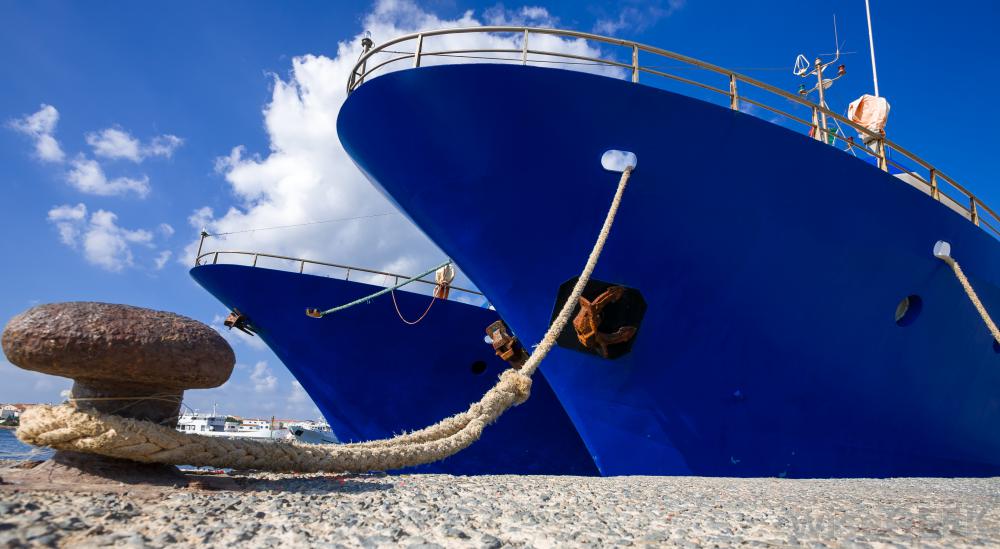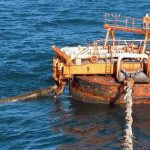In order to bring a hawser from a ship to a jetty, a heaving line is thrown from the ship to the linesmen ashore, who will pull in the hawser and make fast on a puller. When using tug boats, heaving lines are also thrown from the ship, to be picked up by the tug’s crew and fastened to a messenger line. The messenger line is then hauled on board the ship and thereafter follows the towing wire of the tug, which is hauled on board the ship by the winch and made fast.
Being able to throw a heaving line properly, to reach the vicinity of the receiver, has been a recognised seaman’s skill from the days of sailing ships. To add weight and body to the end of the heaving line, the tradition was to either use a heaving line knot or a so-called monkey fist, the latter still being the most popular method in use. An experienced seaman will still be proud of knowing how to make a monkey fist out of rope and of being good at throwing the heaving lines. In the old days it was the job of deck boys to coil up the lines, while the able bodied seamen would do the throwing, an indication of status on board.

A heaving line with a monkey fist made of ropes only.
Dangerous weights
The Belgian tug boat company URS, operating more than 30 tugs from their head office in Antwerp, for the servicing of ships on the Belgian coast and in and out of the busy Belgian and Dutch ports on the river Scheldt, has drawn Gard’s attention to the growing practice of adding dangerous weights to heaving lines. It is recognised that a monkey fist just made up of rope is a bit on the light side if the skills of the thrower are inadequate, so seamen have always been tempted to dip it in lead-based paint or even to put a steel nut or other heavy object inside it. But it has also always been known among seamen that such practices are not appreciated by people on the receiving end of the heaving line.
When a port worker or a crew member on a tug boat receives a dangerous heaving line, he is likely to get angry enough to cut off the monkey fist or whatever heavy weight being used as an attachment. Such trophies collected by URS employees and a collection of items on display in the office of the Antwerp Port Authorities show that they look more like medieval weapons or tools employed to frighten off pirates than something used for the passing of lines from a ship: heavy steel shackles, balls of lead, various steel spare parts, sections of solid rubber, bolts and nuts, to mention but a few.
Monkey fists are normally made up of three turns of rope, and when fists of five and even six turns are found, they are likely to have a heavy object inside. Cutting open such monkey fists, steel nuts, balls of lead or steel, golf balls and even billiard balls have been found. The monkey fist record in Antwerp is 1,070 grams. Someone threw a weight of more than a kilo from the forecastle of a large ship, to pass a heaving line to a person on the small deck of the tugboat far below! As vessels are growing in size, the heights that heaving lines are thrown from make weighted heaving lines more and more dangerous to the receivers.
Lack of regulations
There are not many regulations to be found on how to restrict weights of heaving lines, but at least the “Code for Safe Working Practices for Merchant Seamen” issued by the UK Maritime and Coastguard Agency, is very clear on this subject in section 25.3.2: “Vessels heaving lines should be constructed with a monkey’s fist at one end. To prevent personal injury, the fist should not contain any added weighting material.”
As for the Port of Antwerp, Article 19.8 of the Municipal Police Regulations places clear responsibility on the master of a ship if dangerous heaving lines are being used. A free translation from Dutch reads:
“The use of heaving lines the end of which is weighted in such a way that the action of throwing the line constitutes a hazard and/or cause damage and/or injury is prohibited”. This has created a legal basis for the imposition of fines, and the Antwerp Port Authorities have made use of it when incidents involving dangerous heaving lines have happened. The four most serious cases have resulted in 66 man-days off work due to injuries and there are also cases of damage to cars and other equipment. One person received a weighted monkey fist in his face and was lucky to get just a broken nose. The kinetic energy from such a weight thrown from high above could be sufficient to kill a man or make him permanently disabled if hit in the head. If such a hit should result in death, that could also lead to criminal prosecution for manslaughter against the persons found responsible.

Cutting open a very heavy monkey fist.

The lead ball from inside the monkey fist.
 |  |
| A heavy steel bushing on a heaving line. | A solid piece of rubber gasket, with four steel bolts embedded to gain weight. |
Accidents
Luckily, many near accidents have caused more fright than injury, but over the years Gard has recorded several accidents with heaving lines. In one case a pedestrian on a pavement was hit in the shoulder while looking at a passenger vessel docking in a Swedish port. The heaving line went too far. As it can not be expected that pedestrians wear hard hats if they look at ships, there has to be some common sense on the part of the people on board, both when making heaving lines and when throwing them.
Naturally, the linesman ashore or on board a tug has some responsibility for his own safety. A hard hat should be worn and he should be alert and as far as possible keep out of the “line of fire”. But his job is to catch the line, and the risk of accident is increased if he is on a slippery surface, in the dark or blinded by floodlights – and hard hats have their limits.
Seamen should also know that if excessively weighted heaving lines are not cut off by the receivers on a jetty, they will be returned in the same manner and can then cause injuries to people on board. 
A ball of lead was used as a weight on this heaving
line – a frightening experience for those on the receiving end.
One monkey fist was found to contain a lead ball
weighing 810 grams.

A steel bar used as a weight, covered by a piece
of reinforced hose.
Techniques
It is not always an easy task to get a line from a ship to a tug or a jetty, especially in strong winds. Being good at throwing a heaving line is a seaman’s skill, and that is not a skill picked up there and then. Practice makes perfect, so seamen should be challenged to exercise with heaving lines and not just to fix a steel shackle to the monkey fist when the wind is blowing in the wrong direction. First of all it is important to have a rope that will fly well through the air. In the old days it would always be a rope of natural fibres and one trick was to wet the rope before throwing it. Coiling the rope properly and how the coils are divided and held in the left and the right hand are very important. When the rope is thrown, it is with a powerful swing by a straight arm. Those good at throwing a line in the old days could develop special personal techniques, like throwing a heaving line with both arms. The main throw by the straight, right arm will be followed by the coils in the left, also thrown from the right side, diagonally across the body. In some navies this is still practised.
Monkey fist: how to.
Source: Wikipedia, licensed under the CC-BY-SA common licence.
Linesmen on tug boats will prefer ship heaving lines to be of a coloured and floating material, being easy to see and less likely to end up in propellers. Small diameter rope of 8-10 mm thickness is preferred, not heavier material that may cause injuries. As the tug will usually follow behind the bow-wave of the ship, lines should not be thrown from the extreme forward end of the forecastle, but rather from the shoulder of the ship, not to hit the wheelhouse, but the aft deck of the tug boat. Monkey fists should be of rope only, never weighted and preferably not even dipped in paint, as that makes them very hard. An alternative to the monkey fist could be a ring or ball of soft rubber like those used for lifelines, or a small leader or canvas bag, partly filled with a small amount of sand. Such a bag should be oversized for its content, to reduce the impact if it hits a person.

Work safely with tugs.
Illustration courtesy of URS nv.
Conclusion
Masters are advised to check all heaving lines on board and remove all heavy monkey fists and dangerous attachments. It is important to understand the dangers involved in throwing an object at a receiver on a lower level and the risk of being prosecuted or fined for causing injury to other people and equipment. And last but not least, crew members should be proud of the traditional seaman’s skill of being good at throwing a heaving line. Practice makes perfect.



Comments are closed